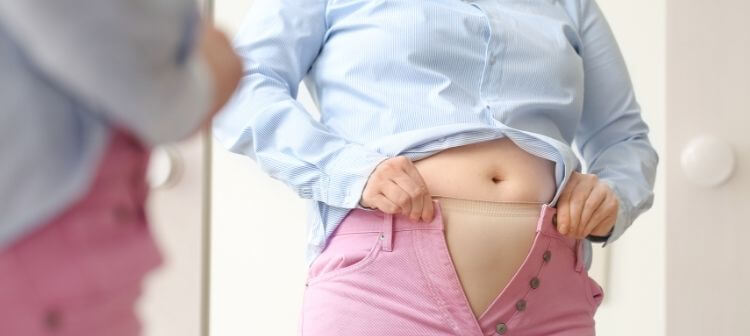The stomach is a common body concern for both men and women, particularly as we age and our metabolism becomes slower and less efficient. Age also often brings considerable lifestyle changes and greater stress. Our body reacts to stress by releasing the hormone cortisol, and elevated cortisol levels increase belly fat.
What are the differences between a tummy tuck and liposuction?
Both the tummy tuck and liposuction are surgical operations that can achieve a flatter, firmer abdomen. But what is the difference between these two cosmetic surgery procedures, and how do you know which is right for you? Here’s the Karidis Clinic guide to the differences between the tummy tuck and lipo.
The procedure
During the tummy tuck procedure, an incision is made just above the pubic area, stretching from hip to hip. Through this extensive incision, your Karidis Clinic can access the abdominal muscle wall. If these muscles have become lax or separated, often caused by pregnancy or significant weight gain, they can be stitched back into position.
A second incision is usually made around the umbilicus to free it from the surrounding tissue. This allows your surgeon to remove any excess skin and fat and stretch the remaining tissue downwards to create a firmer, flatter contour. The umbilicus is then repositioned in a more natural position on the abdomen.
Liposuction, or fat removal surgery, is the targeted removal of fatty deposits using a cannula and vacuum. It can be performed anywhere on the body and even on the face to remove a double chin, but it is particularly popular for eliminating stubborn pockets of fat on the abdomen.
Tiny incisions are made in the target area. Wherever possible, these are positioned in the body’s natural folds so they will be invisible when healed. A tumescent solution is then injected to assist with dislodging the fat cells, and then these are suctioned out.
The results
It is essential to realise that neither procedure is weight loss surgery, so it is best to be at or near your ideal body weight to achieve the best result possible. The question often asked during a tummy tuck or liposuction consultation is whether the results are permanent.
Liposuction offers permanent fat reduction results as the eliminated fat cells can’t grow back. However, the fat cells left behind can expand and increase if you put weight on again in the future. Your Karidis Clinic surgeon will always leave a smooth layer of fat attached to the underside of the skin to minimise any irregularities or rippling of the skin.
The results of your tummy tuck are typically long-lasting, but any significant fluctuations in your weight or subsequent pregnancies can affect the outcome.
The recovery time
Liposuction and tummy tucks are surgical procedures that entail a period of downtime, but they differ in terms of what you can expect.
After liposuction, you’ll be encouraged to be up and about within a day or so, as this promotes healing. Most patients can return to normal activities and work, as long as it’s not strenuous, within a week, and you’ll wear a compression garment to support the treated area. Bruising and swelling can take up to a month to entirely disappear. Any numbness or stiffness should return to normal in six to eight weeks.
An abdominoplasty is a much more major operation, and it can take a few weeks before you feel like yourself again. Some patients can return to work after two weeks, whereas others need more rest. Walking and gentle exertion are encouraged, though, as they help reduce the swelling and stimulate the healing process. Heavy lifting and strenuous activity are prohibited for at least six to eight weeks, and you should always listen to your body.
The scarring
The scarring is one of the significant differences between a tummy tuck and liposuction. The former entails a long incision in the bikini line extending across the stomach. Liposuction, on the other hand, usually involves three or four tiny incisions in the abdomen through which a thin cannula can be passed.
One benefit of the tummy tuck scar is that it can minimise the appearance of a less than aesthetically pleasing C-section scar, which is usually sited higher on the stomach and often creates a shelf of excess skin and tissue.
Can you have a liposuction and a tummy tuck together?
Often, these procedures are performed in conjunction to achieve the optimal aesthetic outcome, and it’s perfectly safe to perform a liposuction and a tummy tuck together.
Do I need liposuction or a tummy tuck?
During your consultation with your Karidis Clinic surgeon, you will discuss your concerns and expectations from cosmetic surgery. They will also perform a comprehensive physical examination and take a complete medical history. Your surgeon can then advise whether lipo or an abdominoplasty is appropriate.
Generally, liposuction eliminates stubborn pockets of fat resistant to diet and exercise. Unlike a tummy tuck, there is minimal scarring, but liposuction can’t address excess, sagging skin. We also offer micro-liposuction, used for smaller areas of the body (face, neck, arms and ankles).
A tummy tuck can tighten lax or separated muscles, often essential for achieving a flatter tummy and narrower waist. It also permanently removes excess skin. However, it is a more extensive surgical procedure, and scarring is more significant.
If you want more advice on whether a tummy tuck or liposuction can deliver the results you’re hoping for, call 0207 432 8727 to arrange a consultation.
















